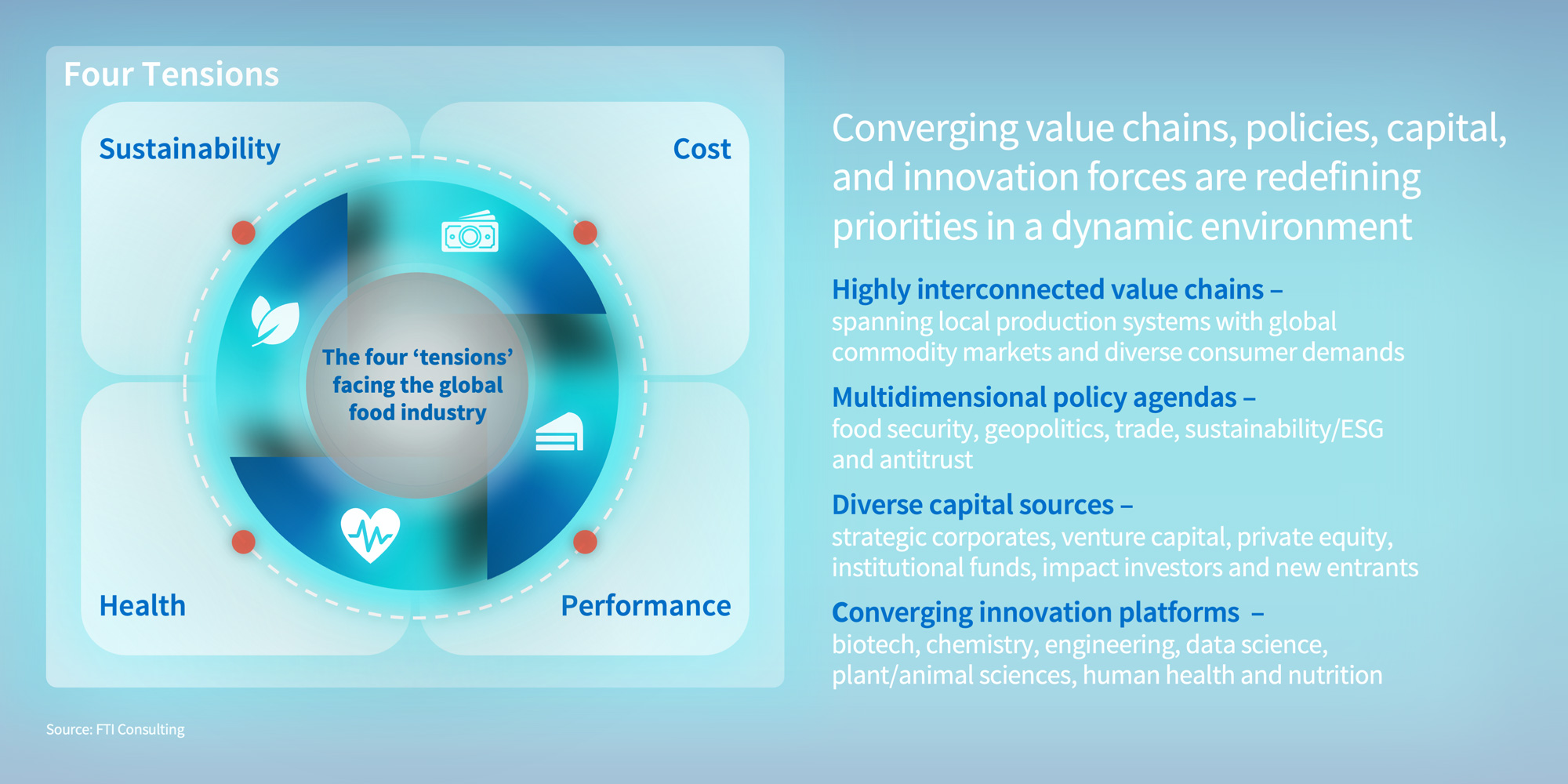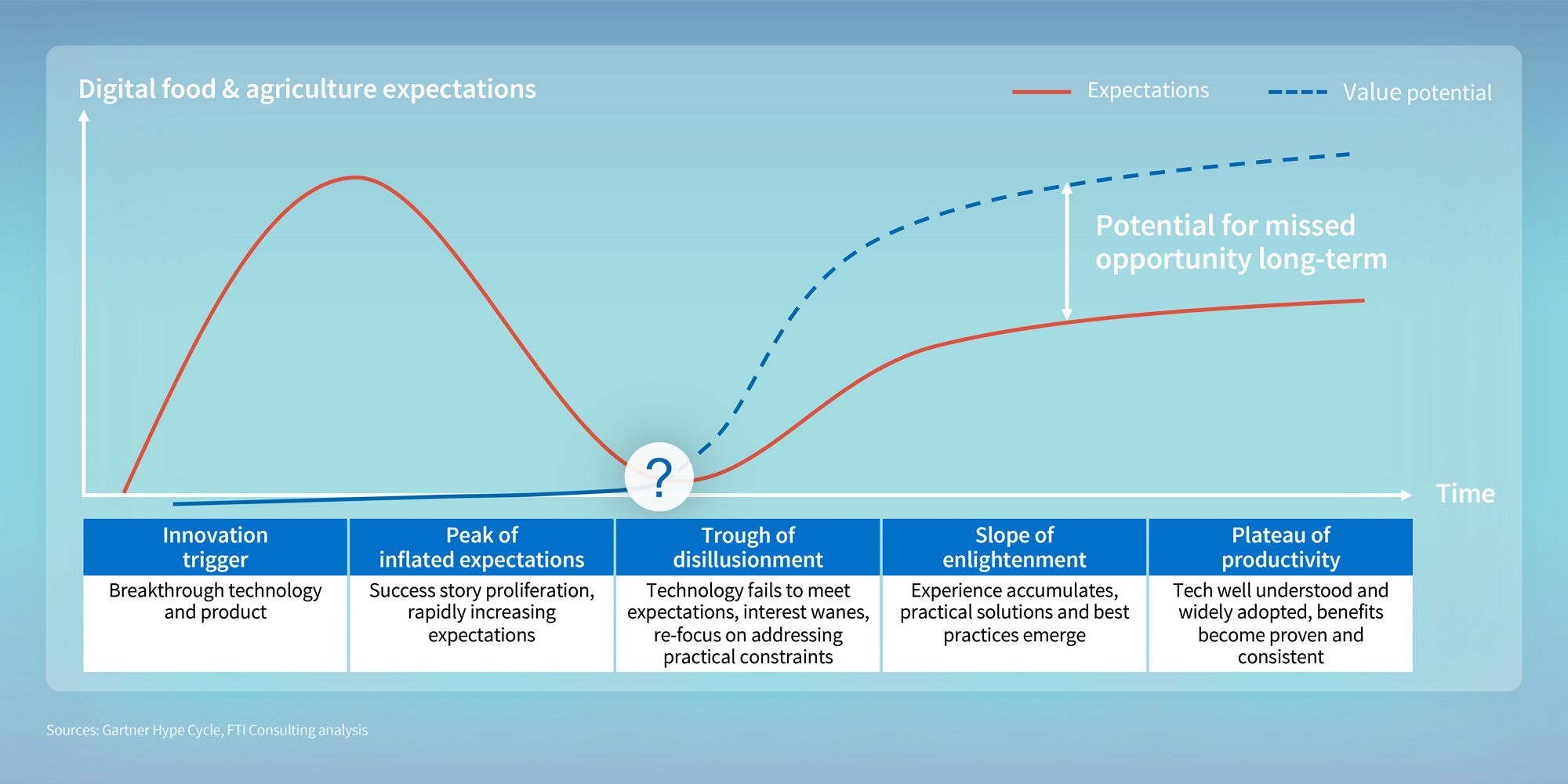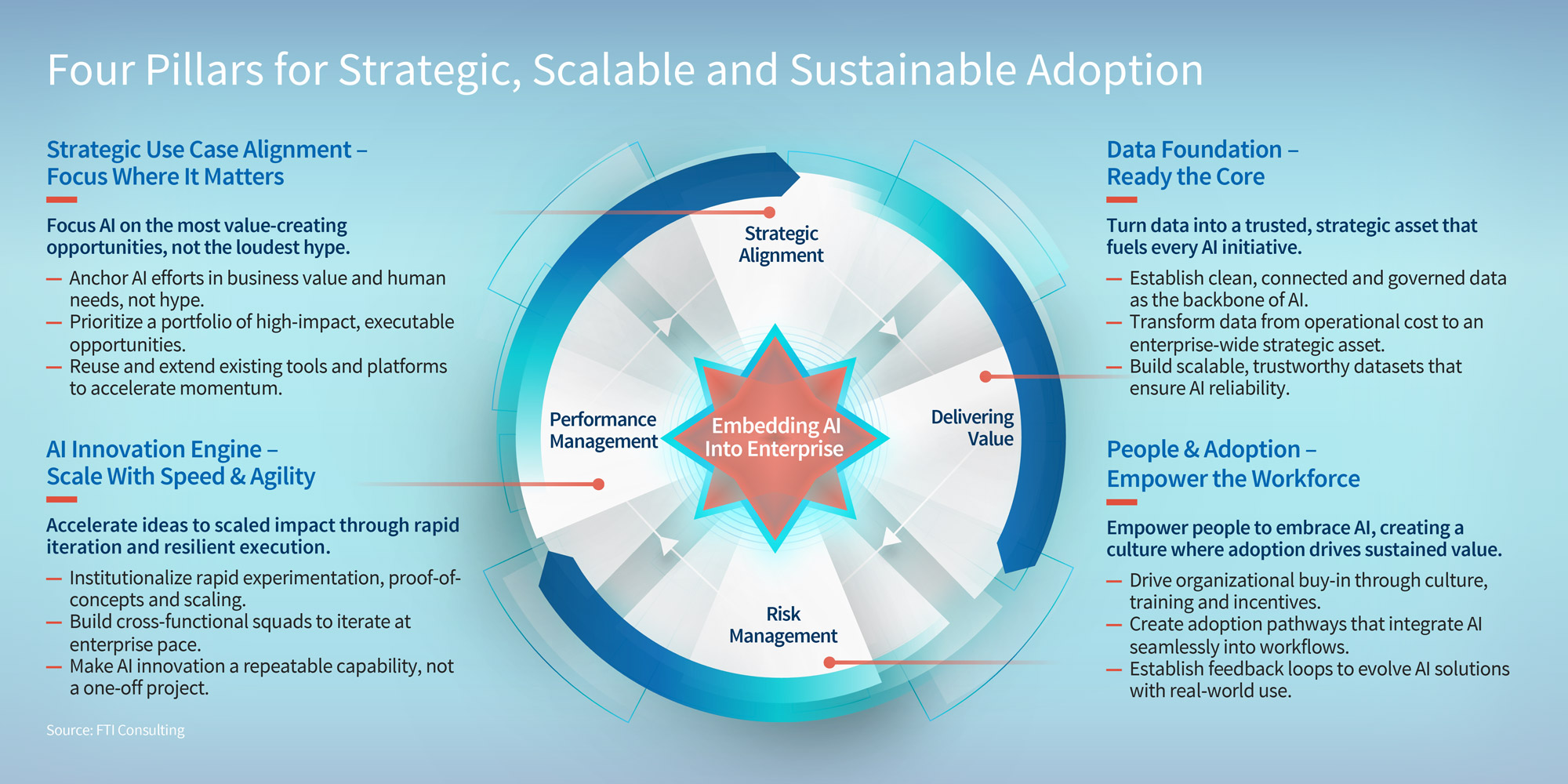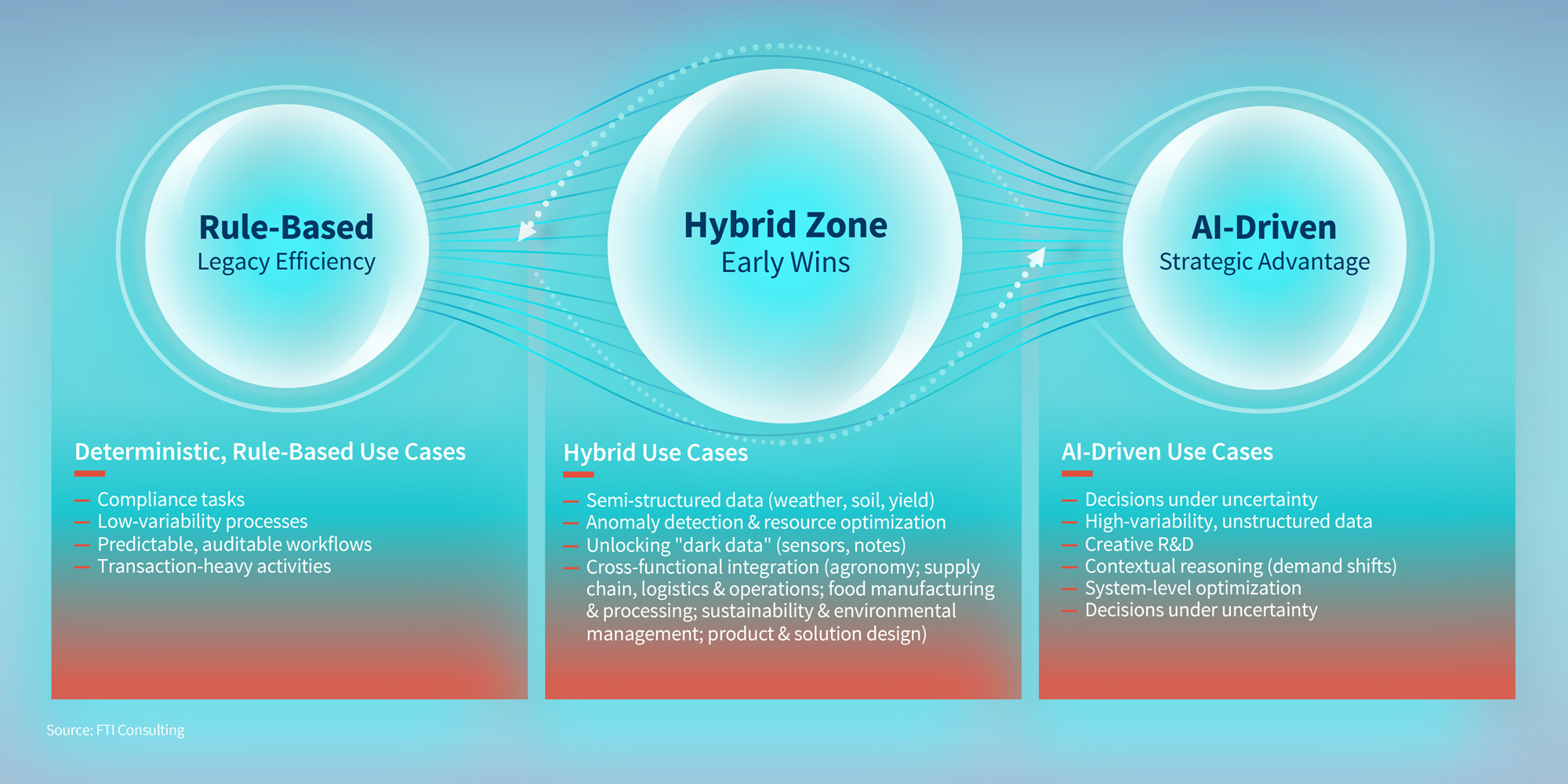- Accueil
- / Publications
- / Articles
- / AI: The Catalyst for Food and Agriculture’s Next Era
AI: The Catalyst for Food and Agriculture’s Next Era
AI’s Role in Shaping Resilience, Sustainability, and Growth in Food and Agriculture
-
octobre 28, 2025
-
The global food and agriculture sector has always been complex and faces unprecedented volatility: rising input costs, shifting consumer demands, intensifying sustainability pressures and evolving health imperatives. These factors are converging to reshape the global food system, creating both disruption and opportunity. At the same time, a new generation of deep learning AI models, including generative AI (“GenAI”), is breaking through barriers that limited past digital transformation initiatives. Unlike older deterministic platforms, today’s AI models thrive in highly multivariate environments, contextualizing information, connecting knowledge silos and augmenting human expertise. For food and agriculture, this means turning complexity into a competitive advantage.
The promise of AI is not without risks. Bias in data, operator resistance, siloed pilots and compliance challenges can all undermine success. And AI is not a silver bullet; without clear priorities, governance and integration, organizations risk adding to complexity and distraction rather than solving for it. The opportunity is real, but it hinges on being thoughtful about where AI is applied and how it is embedded across the enterprise.
That said, a clear lesson is emerging: those who act now can shape the rules of competition for the decade ahead, while those who wait risk falling permanently behind. Today’s AI models are designed to thrive in fragmented, variable environments, integrating data across genetics, agronomy, nutrition, sustainability and consumer demand to deliver insights no previous wave of technology could achieve. This makes AI a defining catalyst for transformation in food and agriculture when applied with focus and foresight.
The Urgency for Change
The future of the food and agriculture sector will be shaped by how effectively organizations leverage AI and digital transformation to navigate the “Four Critical Tensions” of cost, performance, sustainability and health.1 These forces, representing inherent trade-offs, are deeply interconnected and demand new tools and thinking.

The above diagram shows why incremental improvements won’t suffice; AI is the only tool that can manage all four simultaneously.
Cost: Rising input costs and consumer inflation are pressuring companies to protect margins while keeping food affordable. AI can unlock win-wins by enabling precision agriculture to lower inputs and emissions, smarter supply chains to cut waste and costs and product design that balances nutrition, functionality and price — delivering sustainability, health and performance alongside efficiency.
Performance: Today, food is measured by more than taste and price — nutrition, safety, sustainability, convenience and animal welfare are baseline expectations. AI can accelerate product innovation that meets these demands while improving performance. From enhancing nutritional profiles and food safety to optimizing formulations that reduce cost and environmental impact, AI helps create solutions that deliver health, sustainability and profitability together.
Sustainability: Environmental and ethical considerations are no longer optional. AI can embed sustainability into daily operations by monitoring emissions, strengthening traceability and ensuring regulatory compliance — while also leading to win-wins that lower costs, improve efficiency and enhance performance and health outcomes across the value chain.
Health: Health concerns — from ultra-processed foods to chronic disease risks — are reshaping both consumer choices and regulatory priorities. AI can unlock solutions by analyzing complex nutrition and health data. It accelerates the development of healthier products and identifies risks and opportunities earlier in the supply chain, thereby delivering better health outcomes while also reducing costs, supporting sustainability and improving overall product performance.
Taken together, these four tensions highlight why traditional approaches fall short. Improvements in one area often come at the expense of another, leaving companies balancing trade-offs. AI changes the equation by enabling simultaneous gains across cost, performance, sustainability and health — a step-change that conventional tools cannot deliver.
Driving AI Value: AI at an Inflection Point in Food & Agriculture
According to the Gartner Hype Cycle and FTI Consulting analysis (see diagram below), the industry is moving past the “peak of inflated expectations” and the inevitable “trough of disillusionment,” but more importantly towards the “slope of enlightenment,” where meaningful, scaled value creation becomes possible.2
This shift marks a decisive inflection point. Earlier digital waves like enterprise resource planning (“ERP”) systems, the Internet of Things (“IoT”) and early precision agriculture made progress but often stalled in fragmented and variable environments. Today’s deep learning models, including GenAI, are different as they are built to thrive in complexity. They can tailor recommendations to regions and markets; unlock unstructured “dark data”; connect insights across genetics, agronomy, nutrition and consumer demand; and expand the reach of human expertise.

For food and agriculture:
- Early adopters capture disproportionate value, setting new benchmarks in productivity, resilience and sustainability
- Late adopters risk competing on parity as performance baselines move beyond reach
- Non-adopters face outdated processes, eroded margins and higher long-term costs
As emphasized in FTI Consulting’s thought leadership article, “The Fourth AI Inflection,” this is not just another technology cycle, but a chance to embed AI into the core of business models and build durable competitive advantage.3
A Pragmatic Approach to Driving AI Value
AI is no longer about experimentation — it’s about embedding AI into the enterprise fabric in a way that is strategic, scalable and sustainable. To succeed, adoption must avoid being ad-hoc or siloed. Instead, it should be aligned with strategic priorities, anchored in data readiness, scaled through continuous innovation and reinforced and enabled by people and culture. A structured approach ensures that organizations can achieve early wins that build momentum, while laying the foundation for sustainable, enterprise-wide transformation (see diagram below).
In practice, this means:
- Aligning AI opportunities directly with cost, performance, sustainability and health objectives
- Assessing your enterprise data fabric
- Equipping teams with the skills and trust to embed AI into daily decision-making
When integrated with deep sector expertise and financial acumen, these priorities create a pragmatic roadmap for adoption — one that emphasizes scalability, measurable outcomes and a human-centric ethos.
Early Wins
AI will not resolve all of food and agriculture’s challenges, but applied in the right context it is already delivering results. The continuum illustrated in the diagram below highlights this progression: on one end, deterministic, rule-based approaches deliver legacy efficiency; on the other, AI-driven solutions unlock strategic advantage. Between these poles lies the hybrid zone, where process evolution is taking shape and many of the most practical early wins are already emerging.
Most companies are currently in the hybrid zone. Moving towards an AI-driven advantage requires bold, strategic steps now. Early wins are already emerging across the value chain — from upstream R&D to consumer-facing product design — where AI is delivering measurable impact.
Examples include:
- Advancing Upstream Agriculture and R&D: accelerating input innovation, designing resilient inputs, and optimizing input use to reduce costs and boost yields sustainably
- Optimizing Precision Field Operations: deploying AI-driven autonomy and field analytics to reduce labor costs, maximize input precision and improve productivity and efficiency in real time
- Enhancing Supply Chain and Demand Optimization: forecasting demand and optimizing logistics to reduce waste, rebalance supply and improve responsiveness to market shifts
- Streamlining Food Manufacturing & Storage: strengthening quality control, optimizing production and dynamically managing storage to lower costs, reduce spoilage and improve food quality and safety
- Embedding Sustainability and Environmental Health: monitoring soil, water and carbon at scale, optimizing regenerative practices and simplifying sustainability reporting and compliance
- Accelerating Health, Nutrition and New Product Design: using AI-driven insights and simulations to create healthier, consumer-driven products faster and more cost-effectively while balancing producer needs and supply chain realities
AI bridges silos by connecting diverse data streams, thereby enabling actionable insights that drive not only better performance and sustainability, but also reduce costs, boost profitability and advance human health outcomes through tailored nutrition and safer food.
These examples aren’t isolated. Broader industry research confirms the same trajectory. Research shows that early adopters are already realizing measurable benefits — reducing cost-to-serve by more than 20%, increasing revenue per employee by more than 70% and accelerating product development cycles.4 The imperative is to translate these gains into agriculture’s inherently complex context.5
Act Before the Curve Steepens
The food and agriculture sector is no longer in an experimental phase with AI; it has entered an era of scalable value creation. Early movers are already setting new performance baselines, while laggards face rising costs and shrinking relevance.
The choice is clear: Act now to embed AI into strategy and operations, shaping the rules of competition for the next decade, or delay and risk falling permanently behind.
For leaders, the path forward is pragmatic: assess your data foundations, prioritize high-value use cases and launch targeted pilots that deliver both ROI and momentum. But the real opportunity goes further; AI can redefine competitiveness, resilience and trust across the food system.
Those who move first will not only capture growth and protect margins, but also help build a more sustainable, healthy and resilient food future. The moment to lead is here.
Footnotes:
1: Lauren Chupp, Nathan Ramsey, Polly Ruhland, Brandon Banner, Tegan Louw, “Navigating the Four Tensions Shaping the Food and Agribusiness Value Chain,” FTI Consulting (August 18, 2025)
2: “Gartner 2024 Hype Cycle for Emerging Technologies Highlights Developer Productivity, Total Experience, AI and Security,” Gartner (August 21, 2024)
3: Gupta, Sumeet, Claudio Calvino, Madhur Mahajan, “The Fourth AI Inflection,” FTI Consulting (June 12, 2023)
4: Gupta, Sumeet, “The Shape of the Fourth AI Inflection in 2025,” FTI Consulting (January 27, 2025)
5: “Gartner 2024 Hype Cycle for Emerging Technologies Highlights Developer Productivity, Total Experience, AI and Security,” Gartner (August 21, 2024)
Related Insights
Date
octobre 28, 2025
 Contacts
Contacts
Senior Managing Director, Leader of AI & Digital Transformation
Senior Managing Director
Senior Director




